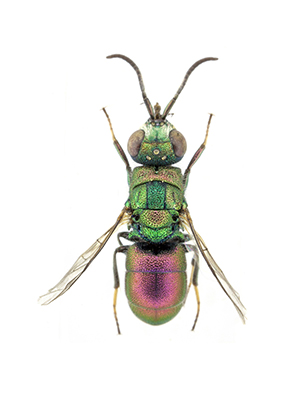Last updated on November 28th, 2023
 From: Kimsey L.S. & Bohart R.M., 1990 (1991) – The chrysidid wasps of the world. Oxford University Press, ix-652 pp.
From: Kimsey L.S. & Bohart R.M., 1990 (1991) – The chrysidid wasps of the world. Oxford University Press, ix-652 pp.
Synonymy
Spintharina Semenov 18926:485. Type: Chrysis vagans Radoszkowski 1877:11. Orig. desig.
Acanthospintharis Balthasar 1953:155. Type: Spintharis houskai Balthasar 1953:155. Orig. desig.
Spintharichrysis Linsenmaier 1951:56. Type: Chrysis versicolor Spinola 1808:241. Orig. desig.
Plexichrysis Balthasar 1957:146. Type: Plexichrysis amoena Balthasar 1957:147 (= Chrysis tenellula Semenov 1910:218). Orig. desig. and monobasic.
Generic diagnosis
Mostly small species (5-7 mm long); some species marked with white on F-I-II (males), tibiae, and T-III distal rim (both sexes) F-I length versus breadth 1-2 times (males) or 1.0-2.9 times (females); F-II in most males and some females shorter than F-III; scapal basin concave, usually microridged medially; TFC nearly always sharp, broadly M-shaped, an inverted U, or a parenthesis; mid ocellar area usually well defined; mid ocellus not lidded except when mid ocellar area is complete; malar space 0.9-3-0 MOD; subantennal space 1-2 MOD; distance between eye and genal carina 0.2 MOD; subgenal area at most partly defined anteriorly; pronotum with medial depression weak, lateral depression large and shallow; fore wing discoidal cell distinct, marginal cell long triangular; metanotum convex and simple; mesopleuron usually with pair of teeth below distinct scrobal sulcus, sometimes multidentate; propodeal angle more or less truncate or apically emarginate; T-I broad; T-II medial length 1.5-2.0 times lateral length, medial carina usually present; T-III sometimes with medial carina, pit row nearly always distinct, apical rim evenly rounded or bluntly pointed (female), weakly emarginate medially, convex or roundly pointed (male), basolaterally usually with convexity, angle, or prominent hook; S-II spots various. Male terminalia: S-VIII triangular; gonocoxa with slender apical projection.
Hosts
Presumably Masaridae. Linsenmaier (1959a) listed Celonites sp. as the host of versicolor. Gess (note on specimen) reported bispinosa in the nesting site of Jugurtia confusa Richards.
Distribution
Most of the 26 species listed inhabit arid zones. The Palearctic Region has 14 species of which 10 are in the Middle East or in North Africa. The Afrotropical Region has 12 species.
Discussion
The truncate or apically emarginate propodeal projection distinguishes Spintharina from other Chrysidini except Spintharosoma. Spintharosoma also has white leg bands, white distal rim of T-III, a weakly biangulate mesopleuron, and coarsely punctate terga; all features of some species of Spintharina. However, there are several important differences. In Spintharina the fore wing marginal cell is triangular, the pronotal declivity has two pits instead of three, the subgenal area is partly defined, the genal carina is closer to the eye, the malar space is distinct, T-III is not notched apicomedially, T-II is not unusually short laterally, and male F-I is not ring-like. The posteriorly emarginate propodeal angle of Spintharina distinguishes it from species placed in Spintharis, Chrysis, and Dichrysis. Zimmermann (1950, 1959) discussed these relationships and was the first to recognize Spintharina and Spintharosoma as distinct genera. Unfortunately, Linsenmaier (1959, 1968) did not agree with Zimmermann in this respect, and confused Spintharina with several species of Chrysis. Bohart (1987b) described six new species and presented a key to the genus, with indication of species groups. Five of these can be distinguished: (1) cyanophris group, with hind tibia plainly white banded on the outer side; (2) vagans group, with T-III almost completely rimmed by a pale translucent band; (3) versicolor group with none of the above and an angular or lobular basolateral projection on T- III; (4) innesi group, with none of the above and malar space 1.7-2.5 MOD; and (5) pleuralis group with none of the above and malar space about l MOD (0.9-1.2). Balthasar (1953) described a new subgenus of Spintharis, Acanthospintharis, with houskai as the generotype. We place houskai as a member of the vagans group of Spintharina. Spintharichrysis Linsenmaier (1951) and Plexichrysis Balthasar (1953) represent species groups of Spintharina at most. We have not examined bleuthgeni, integerrima, and sulcianalis, but they are supposedly related to versicolor according to Mocsáry (1889) and Linsenmaier (1959, 1968).
European species
Copyright, Authorship, and Ownership statements
All text and images of this page are copyright ©️ Chrysis.net unless otherwise stated - please see individual cases for authorship and copyright details. The specimens pictured are from the authors' or other collaborators' personal collections and from the collections of various museums. Unless otherwise specified, the whole content of this web site is for personal, non-commercial, scientific, and educational purposes given proper accreditation to the page from which they were derived are provided, and under Chrysis.net Terms and Conditions.
For citation purposes
Agnoli G.L. & Rosa P. (2025) Genus Spintharina Semenov, 1892, in: Chrysis.net website. Interim version 22 April 2025, URL: https://www.chrysis.net/database/genus-spintharina/.




